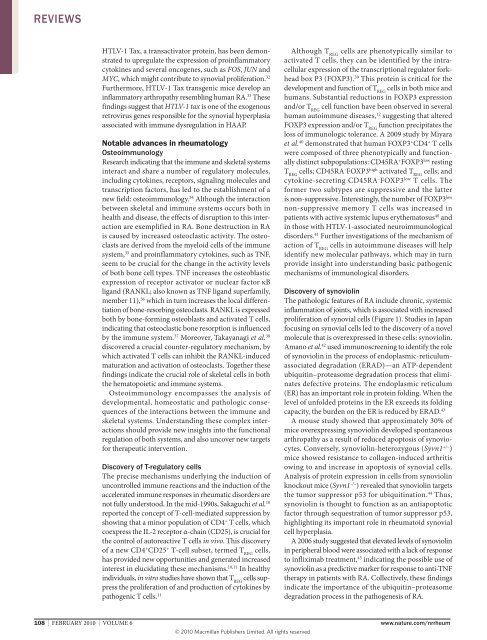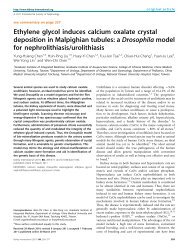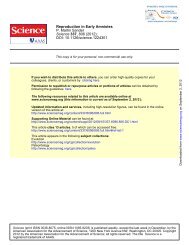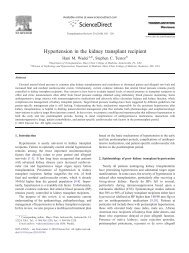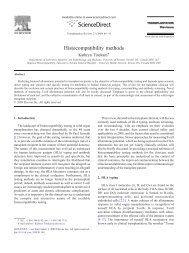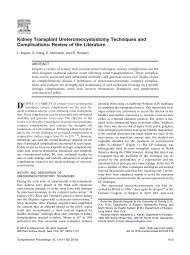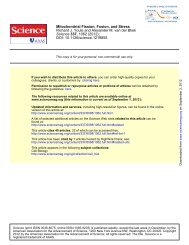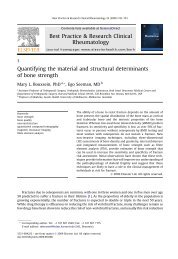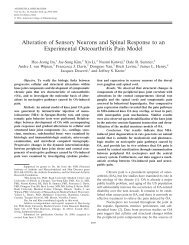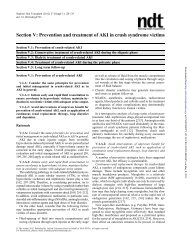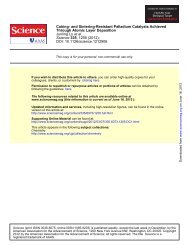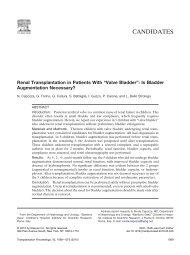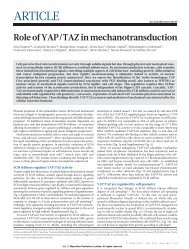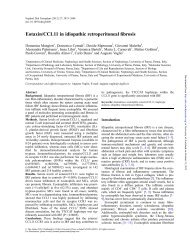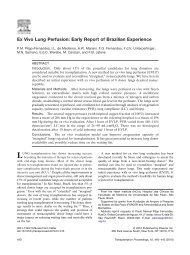The contribution of Asian researchers to the field of rheumatology
The contribution of Asian researchers to the field of rheumatology
The contribution of Asian researchers to the field of rheumatology
Create successful ePaper yourself
Turn your PDF publications into a flip-book with our unique Google optimized e-Paper software.
eviews<br />
HTLV-1 Tax, a transactiva<strong>to</strong>r protein, has been demonstrated<br />
<strong>to</strong> upregulate <strong>the</strong> expression <strong>of</strong> proinflamma<strong>to</strong>ry<br />
cy<strong>to</strong>kines and several oncogenes, such as FOS, JUN and<br />
MYC, which might contribute <strong>to</strong> synovial proliferation. 32<br />
Fur<strong>the</strong>rmore, HTLV-1 Tax transgenic mice develop an<br />
inflamma<strong>to</strong>ry arthropathy resembling human RA. 33 <strong>The</strong>se<br />
findings suggest that HTLV‑1 tax is one <strong>of</strong> <strong>the</strong> exogenous<br />
retrovirus genes responsible for <strong>the</strong> synovial hyperplasia<br />
associated with immune dysregulation in HAAP.<br />
Notable advances in rheuma<strong>to</strong>logy<br />
osteoimmunology<br />
Research indicating that <strong>the</strong> immune and skeletal systems<br />
interact and share a number <strong>of</strong> regula<strong>to</strong>ry molecules,<br />
including cy<strong>to</strong>kines, recep<strong>to</strong>rs, signaling molecules and<br />
transcription fac<strong>to</strong>rs, has led <strong>to</strong> <strong>the</strong> establishment <strong>of</strong> a<br />
new <strong>field</strong>: osteoimmunology. 34 Although <strong>the</strong> inter action<br />
between skeletal and immune systems occurs both in<br />
health and disease, <strong>the</strong> effects <strong>of</strong> disruption <strong>to</strong> this interaction<br />
are exemplified in RA. Bone destruction in RA<br />
is caused by increased osteoclastic activity. <strong>The</strong> osteoclasts<br />
are derived from <strong>the</strong> myeloid cells <strong>of</strong> <strong>the</strong> immune<br />
system, 35 and proinflamma<strong>to</strong>ry cy<strong>to</strong>kines, such as TNF,<br />
seem <strong>to</strong> be crucial for <strong>the</strong> change in <strong>the</strong> activity levels<br />
<strong>of</strong> both bone cell types. TNF increases <strong>the</strong> osteoblastic<br />
expression <strong>of</strong> recep<strong>to</strong>r activa<strong>to</strong>r or nuclear fac<strong>to</strong>r κB<br />
ligand (RANKL; also known as TNF ligand super family,<br />
member 11), 36 which in turn increases <strong>the</strong> local differentiation<br />
<strong>of</strong> bone-resorbing osteoclasts. RANKL is expressed<br />
both by bone-forming osteoblasts and activated T cells,<br />
indicating that osteoclastic bone resorption is influenced<br />
by <strong>the</strong> immune system. 37 Moreover, Takayanagi et al. 38<br />
discovered a crucial counter-regula<strong>to</strong>ry mechanism, by<br />
which activated T cells can inhibit <strong>the</strong> RANKL-induced<br />
maturation and activation <strong>of</strong> osteoclasts. Toge<strong>the</strong>r <strong>the</strong>se<br />
findings indicate <strong>the</strong> crucial role <strong>of</strong> skeletal cells in both<br />
<strong>the</strong> hema<strong>to</strong>poietic and immune systems.<br />
Osteoimmunology encompasses <strong>the</strong> analysis <strong>of</strong><br />
develop mental, homeostatic and pathologic consequences<br />
<strong>of</strong> <strong>the</strong> interactions between <strong>the</strong> immune and<br />
skeletal systems. understanding <strong>the</strong>se complex interactions<br />
should provide new insights in<strong>to</strong> <strong>the</strong> functional<br />
regulation <strong>of</strong> both systems, and also uncover new targets<br />
for <strong>the</strong>rapeutic intervention.<br />
Discovery <strong>of</strong> T‑regula<strong>to</strong>ry cells<br />
<strong>The</strong> precise mechanisms underlying <strong>the</strong> induction <strong>of</strong><br />
uncontrolled immune reactions and <strong>the</strong> induction <strong>of</strong> <strong>the</strong><br />
accelerated immune responses in rheumatic disorders are<br />
not fully unders<strong>to</strong>od. In <strong>the</strong> mid-1990s, Sakaguchi et al. 10<br />
reported <strong>the</strong> concept <strong>of</strong> T-cell-mediated suppression by<br />
showing that a minor population <strong>of</strong> CD4 + T cells, which<br />
coexpress <strong>the</strong> IL-2 recep<strong>to</strong>r α-chain (CD25), is crucial for<br />
<strong>the</strong> control <strong>of</strong> au<strong>to</strong>reactive T cells in vivo. This discovery<br />
<strong>of</strong> a new CD4 + CD25 + T-cell subset, termed T REG cells,<br />
has provided new opportunities and generated increased<br />
interest in elucidating <strong>the</strong>se mechanisms. 10,11 In healthy<br />
individuals, in vitro studies have shown that T REG cells suppress<br />
<strong>the</strong> proliferation <strong>of</strong> and production <strong>of</strong> cy<strong>to</strong>kines by<br />
pathogenic T cells. 11<br />
Although T REG cells are phenotypically similar <strong>to</strong><br />
activated T cells, <strong>the</strong>y can be identified by <strong>the</strong> intracellular<br />
expression <strong>of</strong> <strong>the</strong> transcriptional regula<strong>to</strong>r forkhead<br />
box P3 (FOXP3). 39 This protein is critical for <strong>the</strong><br />
develop ment and function <strong>of</strong> T REG cells in both mice and<br />
humans. Substantial reductions in FOXP3 expression<br />
and/or T REG cell function have been observed in several<br />
human au<strong>to</strong>immune diseases, 12 suggesting that altered<br />
FOXP3 expression and/or T REG function precipitates <strong>the</strong><br />
loss <strong>of</strong> immunologic <strong>to</strong>lerance. A 2009 study by Miyara<br />
et al. 40 demonstrated that human FOXP3 + CD4 + T cells<br />
were composed <strong>of</strong> three phenotypically and functionally<br />
distinct subpopulations: CD45RA + FOXP3 low resting<br />
T REG cells; CD45RA – FOXP3 high activated T REG cells; and<br />
cy<strong>to</strong>kine-secreting CD45RA – FOXP3 low T cells. <strong>The</strong><br />
former two subtypes are suppressive and <strong>the</strong> latter<br />
is non-suppressive. Interestingly, <strong>the</strong> number <strong>of</strong> FOXP3 low<br />
non-suppressive memory T cells was increased in<br />
patients with active systemic lupus ery<strong>the</strong>ma<strong>to</strong>sus 40 and<br />
in those with HTLV-1-associated neuroimmunological<br />
disorders. 41 Fur<strong>the</strong>r investigations <strong>of</strong> <strong>the</strong> mechanism <strong>of</strong><br />
action <strong>of</strong> T REG cells in au<strong>to</strong>immune diseases will help<br />
identify new molecular pathways, which may in turn<br />
provide insight in<strong>to</strong> understanding basic pathogenic<br />
mechanisms <strong>of</strong> immunological disorders.<br />
Discovery <strong>of</strong> synoviolin<br />
<strong>The</strong> pathologic features <strong>of</strong> RA include chronic, systemic<br />
inflammation <strong>of</strong> joints, which is associated with increased<br />
proliferation <strong>of</strong> synovial cells (Figure 1). Studies in Japan<br />
focusing on synovial cells led <strong>to</strong> <strong>the</strong> discovery <strong>of</strong> a novel<br />
molecule that is overexpressed in <strong>the</strong>se cells: synoviolin.<br />
Amano et al. 42 used immunoscreening <strong>to</strong> identify <strong>the</strong> role<br />
<strong>of</strong> synoviolin in <strong>the</strong> process <strong>of</strong> endoplasmic-reticulumassociated<br />
degradation (ERAD)—an ATP-dependent<br />
ubiquitin–proteasome degradation process that eliminates<br />
defective proteins. <strong>The</strong> endoplasmic reticulum<br />
(ER) has an important role in protein folding. When <strong>the</strong><br />
level <strong>of</strong> unfolded proteins in <strong>the</strong> ER exceeds its folding<br />
capacity, <strong>the</strong> burden on <strong>the</strong> ER is reduced by ERAD. 43<br />
A mouse study showed that approximately 30% <strong>of</strong><br />
mice overexpressing synoviolin developed spontaneous<br />
arthropathy as a result <strong>of</strong> reduced apop<strong>to</strong>sis <strong>of</strong> synoviocytes.<br />
Conversely, synoviolin-heterozygous (Syvn1 +/– )<br />
mice showed resistance <strong>to</strong> collagen-induced arthritis<br />
owing <strong>to</strong> and increase in apop<strong>to</strong>sis <strong>of</strong> synovial cells.<br />
Analysis <strong>of</strong> protein expression in cells from synoviolin<br />
knockout mice (Syvn1 –/– ) revealed that synoviolin targets<br />
<strong>the</strong> tumor suppressor p53 for ubiquitination. 44 Thus,<br />
synovi olin is thought <strong>to</strong> function as an antiapop<strong>to</strong>tic<br />
fac<strong>to</strong>r through sequestration <strong>of</strong> tumor suppressor p53,<br />
highlighting its important role in rheuma<strong>to</strong>id synovial<br />
cell hyperplasia.<br />
A 2006 study suggested that elevated levels <strong>of</strong> synovio lin<br />
in peripheral blood were associated with a lack <strong>of</strong> response<br />
<strong>to</strong> infliximab treatment, 45 indicating <strong>the</strong> possible use <strong>of</strong><br />
synoviolin as a predictive marker for response <strong>to</strong> anti-TNF<br />
<strong>the</strong>rapy in patients with RA. Collectively, <strong>the</strong>se findings<br />
indicate <strong>the</strong> importance <strong>of</strong> <strong>the</strong> ubiquitin– proteasome<br />
degrada tion process in <strong>the</strong> pathogenesis <strong>of</strong> RA.<br />
108 | FEBRUARY 2010 | volUmE 6 www.nature.com/nrrheum<br />
© 20 10<br />
Macmillan Publishers Limited. All rights reserved


